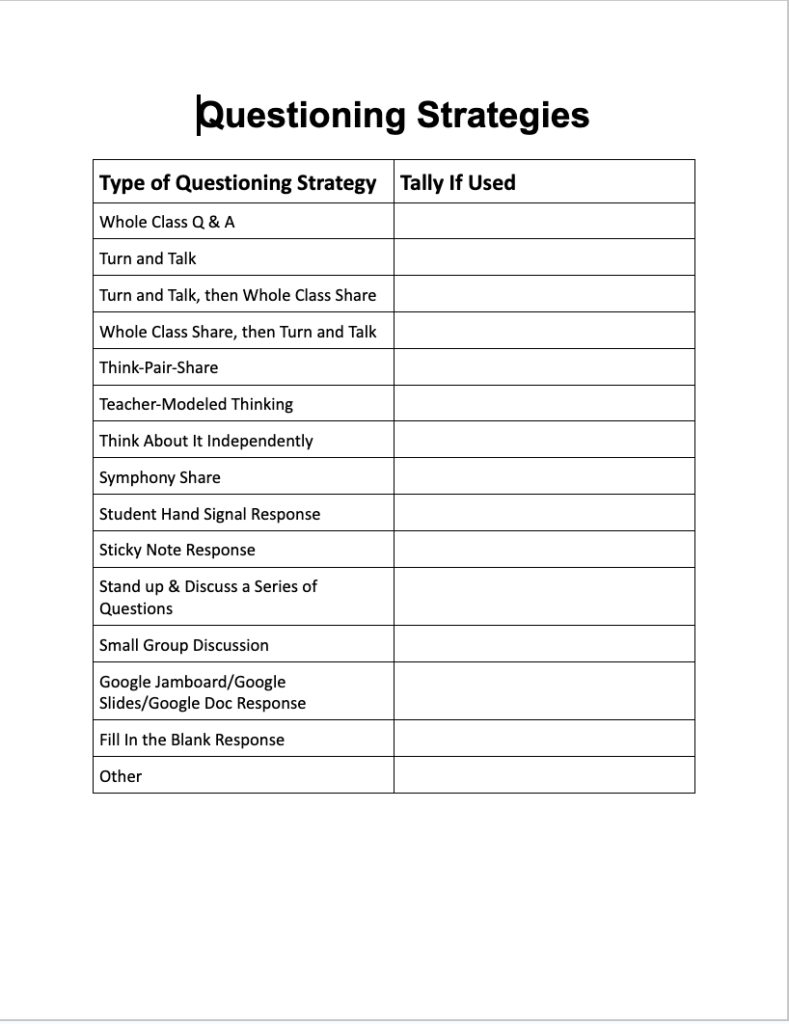Most teachers, including myself, have a default mode when it comes to how we ask students questions across a class period. 95% of the time, that default mode is whole class question and answer. This is when we throw out a question to the whole class and then call on students one-by-one to respond.
So what’s wrong with doing that? Relentless whole class question and answer can lead to students feeling bored, like they can’t think fast enough, or like someone else has the answers for them. It also can flare up classroom management issues and be a huge time sucker.
So what other ways can you ask students questions during a class period besides using whole class Q & A?
Remember as you’re making your questioning strategies plan that it’s not feasible to use every type of questioning strategy that I mentioned in this blog post. Start with 2-3 questioning strategies that you can teach your students how to use and feel comfortable using consistently in your classroom. Concentrate on teaching students the exact expectations for how to use a specific strategy. These strategies encourage all students in the classroom to think about their responses to questions instead of just a few. This shift will up student engagement and understanding of the content.
- Turn and Talk: Pose a question to students and have them turn to one person sitting next to them and take turns sharing their thinking. Other variations for this common questioning strategy are turn and talk followed by a whole class share or a whole class share and then a shift to the turn and talk.
- Teacher-Modeled Thinking: Pose a question and then open up your thinking process to students as you answer the question yourself. This works especially well for complex questions.
- Think About It: Pose a question and then ask students to think about it in their heads or jot their thinking down on a piece of paper.
- Symphony Share: Pose a question and have students form a circle around the classroom. Go in the order students are standing/sitting and have each student share one response to the question. It should be a rather straight-forward question so students’ answers don’t get too lengthy.
- Student Hand Signals: Pose a question to students that could be answered with a thumbs up/thumbs down or on a scale of 1-5 so students can hold up their fingers.
- Sticky Note Response: Post a question and have students jot their response on a sticky note. After students have their responses written, you could have them turn and talk or stick the responses in a certain part of your classroom so they can be sorted and shared.
- Stand Up and Discuss: Pose a question after students have been sitting for an extended period of time or seem to need movement. Ask students to get up and share their response with another student or depending on the type of question/questions, have students share their response with multiple students as they circulate around the classroom.
- Small Group Discussion: If you have your tables/desks organized in groups, take advantage of the seating arrangement and have students discuss a question or set of questions in their small group.
- Google Jamboard/Slides/Docs: Share a Google Jamboard, Slides, or Doc with students on Google Classroom so they can collaboratively share their thinking in response to a question at the same time.
- Fill in the Blank Response: Give a statement but leave out a key concept out of the statement. Ask students to say the word they think would go in the blank in unison.
Two filters to think about when forming questions for students are:
- Do my students know how to use this type of questioning strategy?
- Does this need to be a question, or would explaining/commenting be just as effective?
- Does the questioning strategy I want to use line up to the amount of instructional time I have?
As middle school ELA teachers, we have a lot of places across a daily class period where we ask students questions. Using a variety of questioning techniques will help in the areas of student engagement and classroom management.
If you’re interested in keeping track of the questioning techniques you use across a given class period, click the picture below for your free download. This form also works great for peer observation.






